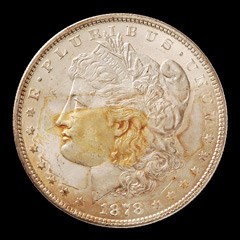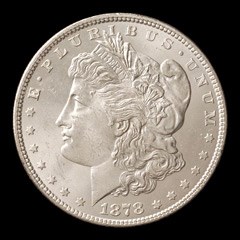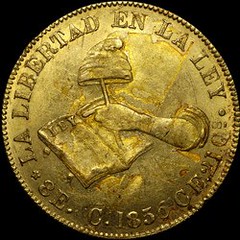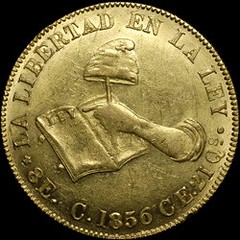
PREV ARTICLE
NEXT ARTICLE
FULL ISSUE
PREV FULL ISSUE
NUMISMATIC CONSERVATION: GLUE RESIDUEWe're had some recent discussions on numismatic conservation. The folks at NGC Numismatic Conservation Services published an article on March 14, 2017 about mitigating the effect
of glue residue on coins. This is a common problem, particularly with coin that may have been mounted for exhibit or marketing purposes at one time in their history. -Editor
The ill effects of glue residue can range from yellow toning to environmental damage.  
1878-S Morgan dollar Yellowed glue residue removed Residues are not only unattractive but, more importantly, can create permanent surface changes that will damage the coins we value. While many residues do not have specific causes some do. Glue residue can actively change the surface chemistry of a coin and, if not removed, leave it ineligible for NGC grading. Glue residue is often a raised substance on the surface of a coin and usually on one side in a specific location. The substance is typically a different texture than the coin's original metal surface. With time, glue residue will yellow leaving an unappealing visual indication. Many times, though not always, glue residue will be sticky to the touch and attract further dirt and lint from the immediate environment.  
1856C Mexico 8 Escudo Gold Glue residue in the shape of transparent tape removed A coin can acquire glue residue from a myriad of scenarios. These may include mounting in a holder or frame with a hardened liquid adhesive or held in place with a strip of transparent tape. Coins may have been secured by various adhesive substances for display or storage when it was used in daily commerce and long before it had any additional numismatic value. When glue residue is present, professional removal is recommended. Removing glue residue can come with some concerns. Most of the time glue residue can be removed from the surface leaving a clean, relatively damage free surface. Many times, however, the glue substance can affect the surface. The result may range from a pattern in the toning to irreversible environmental damage in a clear shape where the glue was. When the visual difference is a case of toning, steps can usually be taken by the NCS conservators to minimize the impact. Permanent environmental damage, however, cannot be easily minimized. Glue residue can sometimes be mistaken for a mint error. This is especially true if the glue residue has the impression of another coin in it appearing as a sought after multiple strike mint error. The glue containing the secondary image will be yellowed and will be at least somewhat transparent to see the true surface of the coin. This thick type of glue will often contain air bubbles that even when tiny are observable. The secondary image will also have the visual texture difference even if it's a shiner matte appearance compared to the tie surface of the coin. Glue removal will be recommended in cases where it is masquerading as a mint error. I was unaware of instances where glue could simulate a mint error. Interesting. Above are two before-and-after images of glue removal. -Editor
To read the complete article, see:
To read the earlier E-Sylum article, see:
 Wayne Homren, Editor The Numismatic Bibliomania Society is a non-profit organization promoting numismatic literature. See our web site at coinbooks.org. To submit items for publication in The E-Sylum, write to the Editor at this address: whomren@gmail.com To subscribe go to: https://my.binhost.com/lists/listinfo/esylum All Rights Reserved. NBS Home Page Contact the NBS webmaster 
|